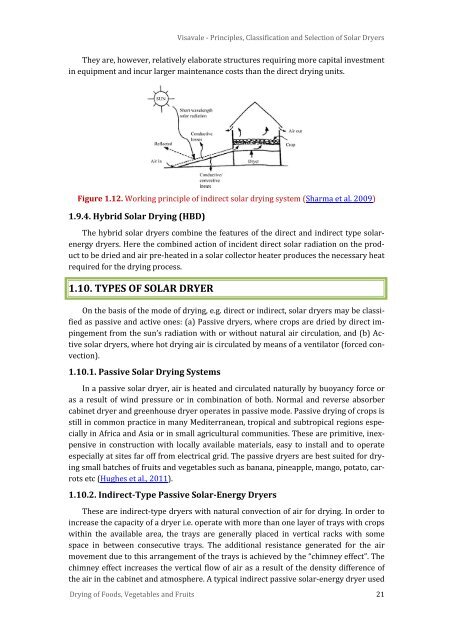Solar Drying: Fundamentals,Applications and Innovations - National ...
Solar Drying: Fundamentals,Applications and Innovations - National ...
Solar Drying: Fundamentals,Applications and Innovations - National ...
You also want an ePaper? Increase the reach of your titles
YUMPU automatically turns print PDFs into web optimized ePapers that Google loves.
Visavale - Principles, Classification <strong>and</strong> Selection of <strong>Solar</strong> Dryers<br />
They are, however, relatively elaborate structures requiring more capital investment<br />
in equipment <strong>and</strong> incur larger maintenance costs than the direct drying units.<br />
Figure 1.12. Working principle of indirect solar drying system (Sharma et al. 2009)<br />
1.9.4. Hybrid <strong>Solar</strong> <strong>Drying</strong> (HBD)<br />
The hybrid solar dryers combine the features of the direct <strong>and</strong> indirect type solarenergy<br />
dryers. Here the combined action of incident direct solar radiation on the product<br />
to be dried <strong>and</strong> air pre-heated in a solar collector heater produces the necessary heat<br />
required for the drying process.<br />
1.10. TYPES OF SOLAR DRYER<br />
On the basis of the mode of drying, e.g. direct or indirect, solar dryers may be classified<br />
as passive <strong>and</strong> active ones: (a) Passive dryers, where crops are dried by direct impingement<br />
from the sun’s radiation with or without natural air circulation, <strong>and</strong> (b) Active<br />
solar dryers, where hot drying air is circulated by means of a ventilator (forced convection).<br />
1.10.1. Passive <strong>Solar</strong> <strong>Drying</strong> Systems<br />
In a passive solar dryer, air is heated <strong>and</strong> circulated naturally by buoyancy force or<br />
as a result of wind pressure or in combination of both. Normal <strong>and</strong> reverse absorber<br />
cabinet dryer <strong>and</strong> greenhouse dryer operates in passive mode. Passive drying of crops is<br />
still in common practice in many Mediterranean, tropical <strong>and</strong> subtropical regions especially<br />
in Africa <strong>and</strong> Asia or in small agricultural communities. These are primitive, inexpensive<br />
in construction with locally available materials, easy to install <strong>and</strong> to operate<br />
especially at sites far off from electrical grid. The passive dryers are best suited for drying<br />
small batches of fruits <strong>and</strong> vegetables such as banana, pineapple, mango, potato, carrots<br />
etc (Hughes et al., 2011).<br />
1.10.2. Indirect-Type Passive <strong>Solar</strong>-Energy Dryers<br />
These are indirect-type dryers with natural convection of air for drying. In order to<br />
increase the capacity of a dryer i.e. operate with more than one layer of trays with crops<br />
within the available area, the trays are generally placed in vertical racks with some<br />
space in between consecutive trays. The additional resistance generated for the air<br />
movement due to this arrangement of the trays is achieved by the “chimney effect”. The<br />
chimney effect increases the vertical flow of air as a result of the density difference of<br />
the air in the cabinet <strong>and</strong> atmosphere. A typical indirect passive solar-energy dryer used<br />
<strong>Drying</strong> of Foods, Vegetables <strong>and</strong> Fruits 21

















